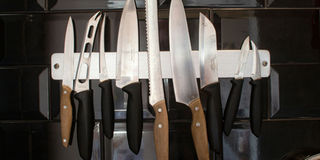Prime
The kitchen knives every cook needs

Using the right knife ensures that you achieve the desired results in your cooking. PHOTO/unsplash.com.
What you need to know:
Different knives are designed for specific tasks, from slicing bread to mincing herbs. Having a variety of knives allows you to tackle a wide range of cooking techniques and ingredients effectively.
How many knives do you need to make your time in the kitchen smooth? Many home cooks often make do with a minimum of two knives, imagine how easier work would get if you had more.
Good knives can indeed be pricey, but you do not have to buy them at ago. Start with the kind of knives critical for your kind of cooking and grow your collection from there. If you are stocking your kitchen, these are the knives you should include.
The chef’s knife
This is the workhorse of the kitchen. It is a versatile, multipurpose knife used for chopping, slicing, dicing, and mincing. A typical length is eight inches, but some prefer six or 10 inches. It is the backbone of the kitchen perfect for tackling everything from vegetables to meats with precision and ease.
Paring knife
A smaller knife with a sharp pointed blade, is ideal for intricate tasks like peeling, trimming, and slicing small fruits and vegetables.
With its small size and sharp pointed blade, the paring knife is indispensable for intricate tasks such as peeling, trimming, and slicing small fruits and vegetables. It is also ideal for detail-oriented work where precision is key, such as deveining shrimp or coring strawberries. When choosing a paring knife, look for a grip in which your hand feels secure enough to wield the knife in the air , while peeling an apple, for example, as opposed to using downward force on a cutting board.
Serrated bread knife
Featuring a serrated edge, the bread knife is specifically designed to slice through bread without crushing it, making it a must-have for any bread lover. It is also the knife used for slicing tomatoes and other delicate fruits or vegetables with tough skins. When choosing a bread knife, look for a long blade that is between seven to 10 inches long.
Boning knife
A boning knife is specifically designed for removing bones from meat, poultry, and fish with precision and ease. It is handy whether you are breaking down a whole chicken or filleting a fish, enabling the cook to make those intricate cuts close to the bone, minimising waste.
Beyond its primary function, a boning knife can also be used for various kitchen tasks, such as trimming fat, skinning, and portioning meat. Its narrow, flexible blade makes it well-suited for tasks that require detailed, delicate work, offering control and maneuverability that other knives may lack.
A boning knife is similar to a fillet knife. The difference is that boning knives are used primarily on meat but also on fish while fillet knives are used exclusively for fish. As long as you get a boning knife with a semi-flexible blade, it can be used on both meat and fish and is therefore more versatile.
Electric carving knife
An electric carving knife is a kitchen tool designed to make slicing and carving various foods easier and more efficient. Unlike traditional knives, electric carving knives feature motorized blades that oscillate rapidly, allowing them to glide effortlessly through meats, bread, and other foods with minimal effort from the user.
If you often host family dinners, holiday gatherings, or parties where they serve large roasts, turkeys, or hams can benefit from the efficiency of an electric carving knife. It can make the task of slicing through large cuts of meat much quicker and easier, allowing hosts to spend more time enjoying the company of their guests.
Electric carving knives require regular cleaning and maintenance to ensure optimal performance and longevity. Blades should be removed and cleaned thoroughly after each use, and the knife should be stored in a safe, dry place.
Users should exercise caution when using electric carving knives, as the blades can be sharp and the motorised action can be powerful. Always follow the manufacturer’s instructions and safety guidelines to avoid accidents.
Materials
When choosing a kitchen knife, it is essential to consider factors such as blade material, hardness, edge retention, ease of sharpening, and overall performance.
Stainless steel is a popular choice for kitchen knives due to its durability, corrosion resistance, and ease of maintenance. It holds an edge well and is relatively easy to sharpen. There are different types of stainless steel, each with its own properties. High-carbon stainless steel, such as VG-10, is known for its excellent edge retention and sharpness.
Cost
The cost of kitchen knives can vary widely depending on various factors such as the materials used, craftsmanship, brand reputation, and whether they are sold individually or as part of a set. One can get a knife for as low Shs10,000 although such a knife may not have the same durability, sharpness, or edge retention as higher-end options but can still serve adequately for basic kitchen tasks.
You can also get a budget knife set ranging from Shs300,000 while high-end sets cost upwards of Shs1m or more.




